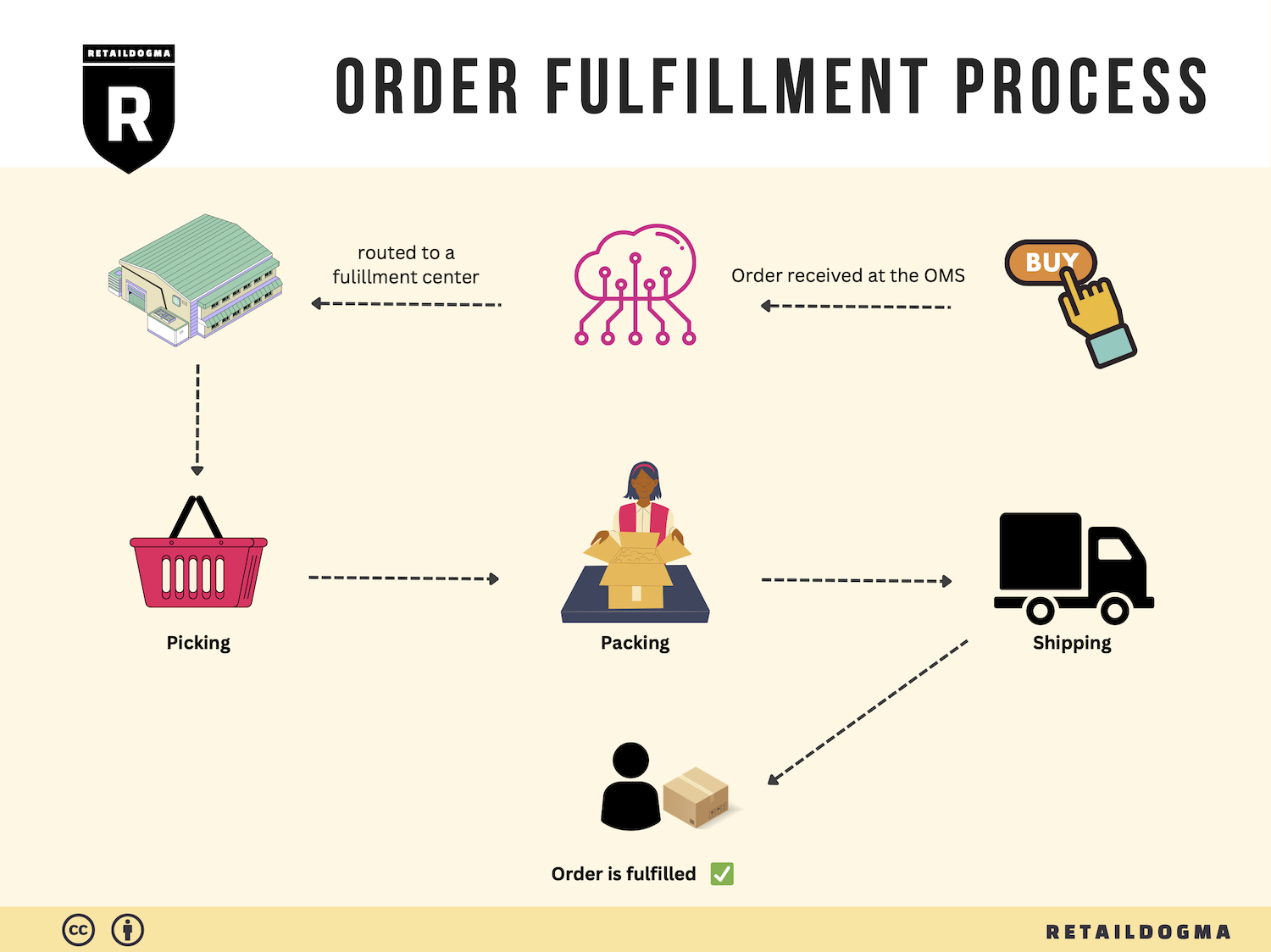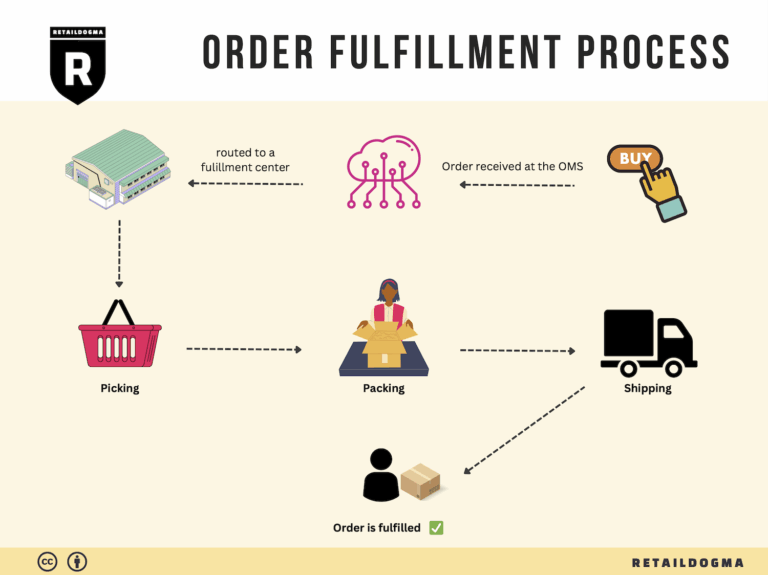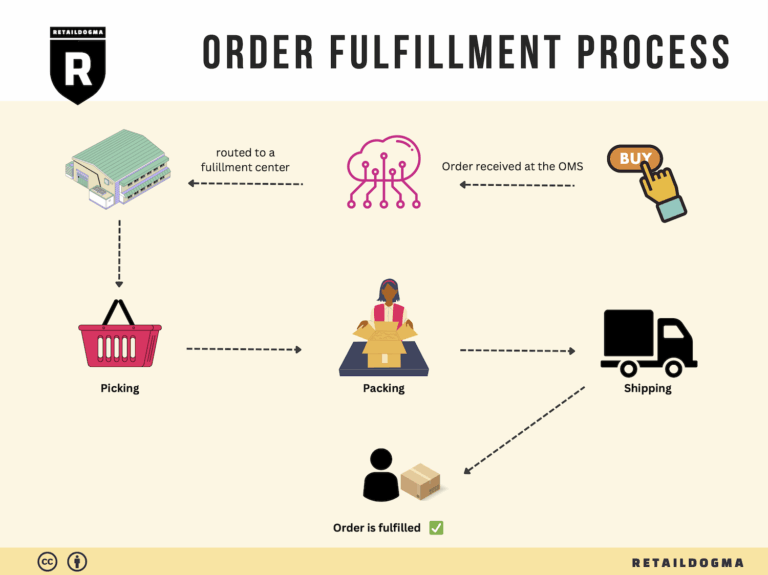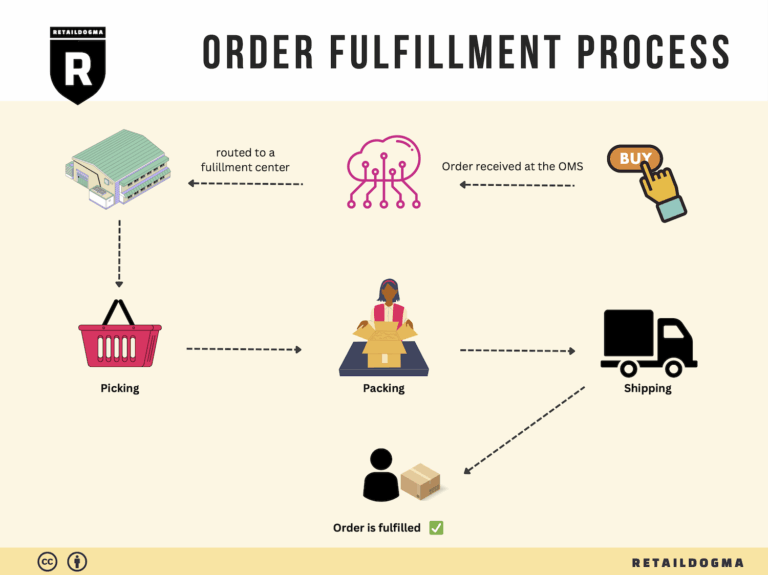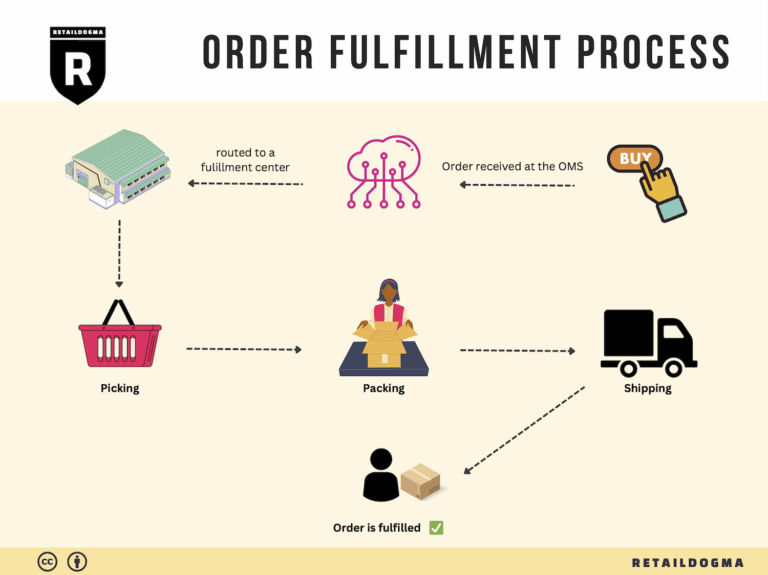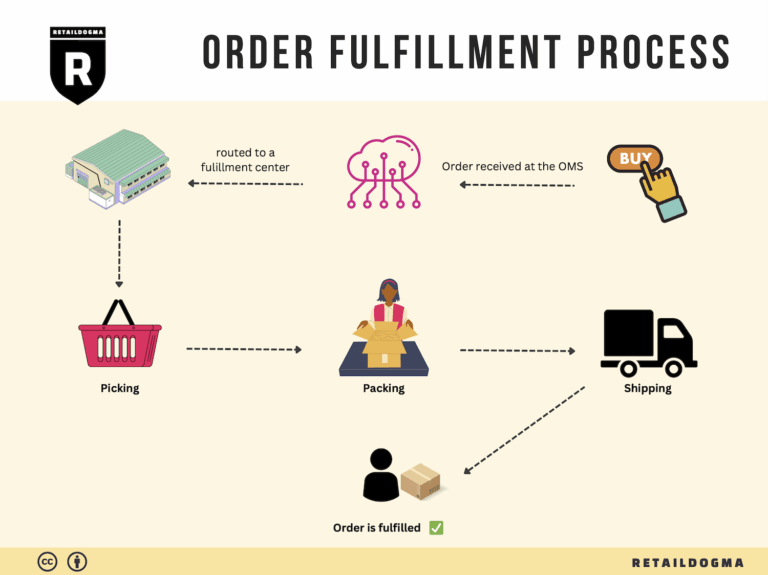What Is A Fulfillment Center? A Complete Guide (2025)
What is E-commerce Fulfillment? An Introduction for Growing Businesses
Understanding E-commerce Fulfillment
For many growing online businesses, the excitement of scaling operations can quickly turn into a daunting challenge when it comes to packing and shipping orders. As order volumes increase, so does the complexity of logistics. Entrepreneurs often find themselves overwhelmed by the demands of fulfilling customer orders efficiently while maintaining high service levels. This is where e-commerce fulfillment comes into play.
E-commerce fulfillment is fundamentally the process of getting a product from your warehouse or fulfillment center to the customer’s doorstep. It encompasses a range of activities, including inventory management, order processing, packing, shipping, and returns management. As your business grows, understanding and optimizing this process becomes crucial to sustaining customer satisfaction and achieving profitability.
In this guide, we will delve into the different fulfillment models available to e-commerce businesses, including Third-Party Logistics (3PL) and Fulfillment by Amazon (FBA). Each model has its advantages and drawbacks, and selecting the right one can significantly impact your operational efficiency and bottom line.
We will also explore the core services typically offered by fulfillment partners, such as warehousing, inventory management, order processing, and shipping. These services can vary widely among providers, so knowing what to look for is essential.
Choosing the right fulfillment partner is another critical aspect we will cover. Factors such as location, technology integration, scalability, and customer service should guide your decision-making process. We will provide practical tips to help you evaluate potential partners effectively, ensuring they align with your business goals and customer expectations.
Finally, we will discuss pricing structures commonly associated with fulfillment services. Understanding these costs is vital for budgeting and can help you identify opportunities for savings as you scale.
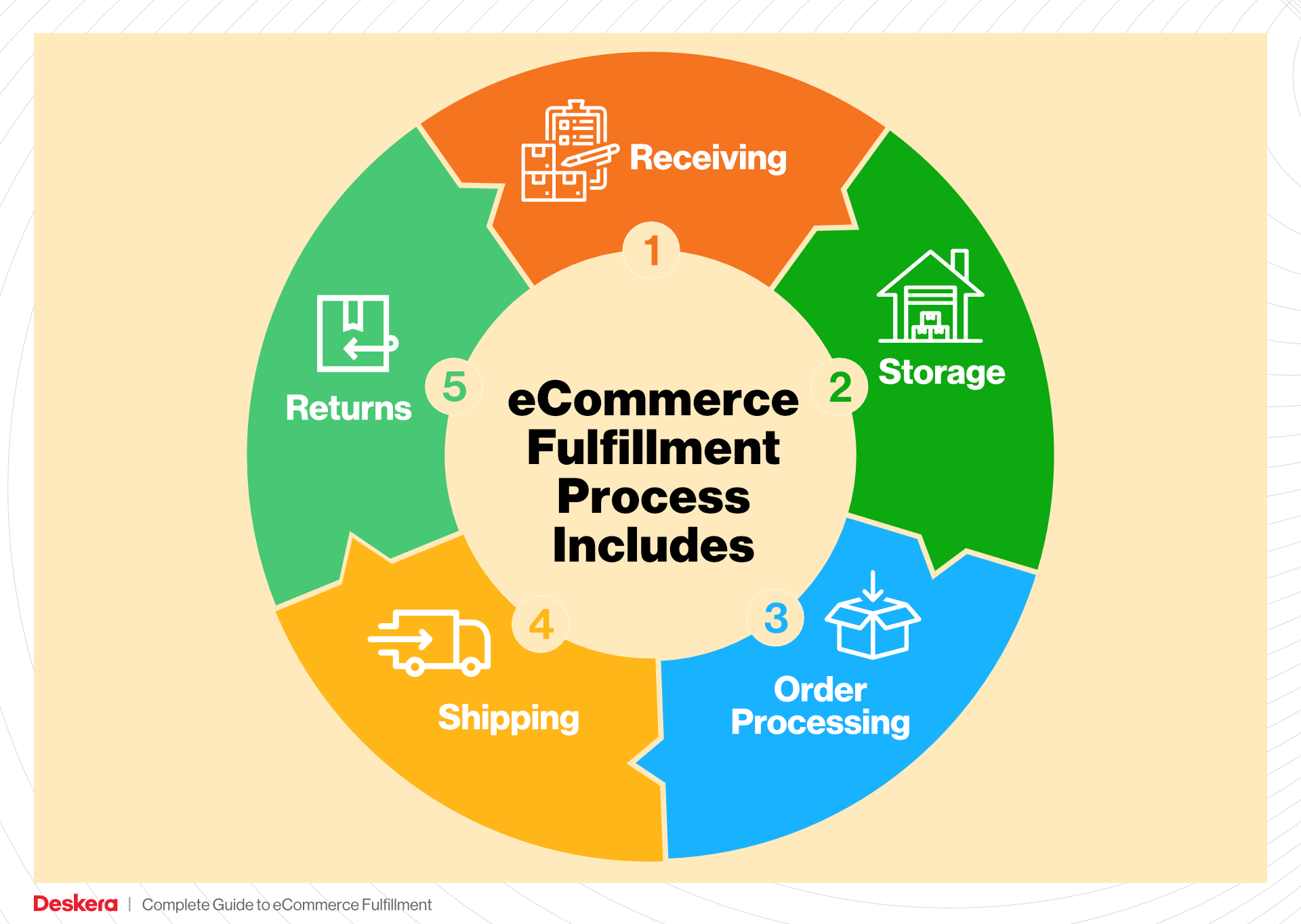
The goal of this guide is to empower you, the business owner, to make informed and strategic decisions about your logistics. By understanding the nuances of e-commerce fulfillment, you can enhance your operational capabilities, improve customer experiences, and ultimately drive growth in your online business.
What You’ll Learn In This Guide
- What is E-commerce Fulfillment? An Introduction for Growing Businesses
- The Order Fulfillment Process: From ‘Buy’ Button to Customer’s Door
- Comparing Fulfillment Models: In-House vs. 3PL vs. Dropshipping
- A Deep Dive into Amazon FBA: Pros, Cons, and Who It’s For
- Core Services Offered by Fulfillment Centers
- How to Choose a Fulfillment Partner: A 6-Point Checklist
- Understanding Fulfillment Pricing: A Breakdown of Common Fees
- Frequently Asked Questions (FAQs) about Fulfillment
- Conclusion: Is Outsourcing Fulfillment the Right Move for Your Business?
- Important Disclaimer
The Order Fulfillment Process: From ‘Buy’ Button to Customer’s Door
1. Receiving Inventory
The first step in the order fulfillment process is receiving inventory. This involves the arrival of goods at your fulfillment center, where they are checked against purchase orders for accuracy. Each item is typically assigned a Stock Keeping Unit (SKU), which is a unique identifier that helps in tracking inventory levels and managing stock efficiently.
Importance: Proper receiving is critical as it ensures that your inventory levels are accurate from the outset. Any discrepancies can lead to issues down the line, such as stockouts or overstocking, which can affect customer satisfaction and operational costs. This step also lays the foundation for effective inventory management, which is vital for scaling your e-commerce business.
Key Term: SKU (Stock Keeping Unit) – A unique identifier for each distinct product and service that can be purchased.
2. Warehouse Storage
Once the inventory is received and checked, the next step is warehouse storage. Items are organized and stored in designated areas within the fulfillment center. This organization can be based on various factors, including product type, size, and demand frequency.
Importance: Efficient storage solutions optimize space and streamline the picking process. By categorizing and strategically placing items, businesses can reduce the time it takes for employees to locate and retrieve products, which is crucial for meeting customer expectations regarding delivery times.
Key Term: FIFO (First In, First Out) – An inventory management method where the oldest stock is sold first, minimizing waste and ensuring product freshness.
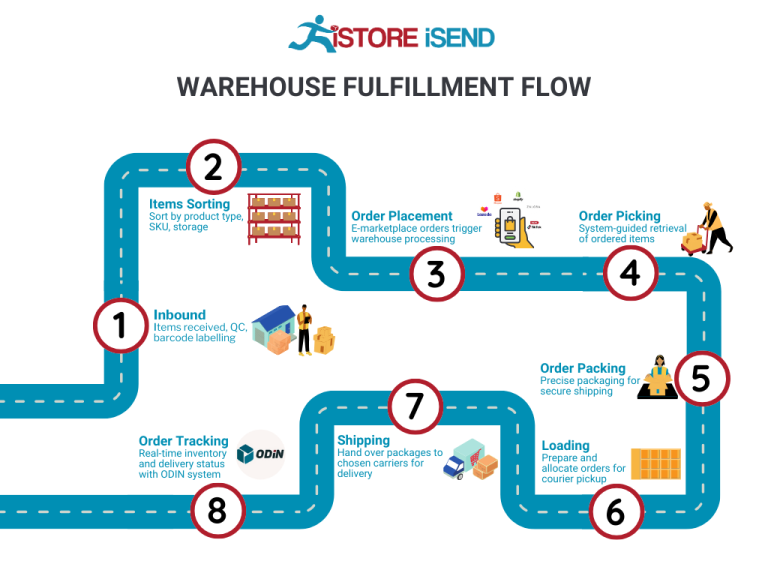
3. Order Picking
Order picking is the process of retrieving the right items from storage to fulfill customer orders. This step often involves the use of pick lists, which are documents that detail the items and quantities needed for each order. Depending on the volume and complexity of orders, businesses may employ various picking methods, such as single order picking, batch picking, or wave picking.
Importance: Accurate picking is essential for maintaining customer satisfaction. Errors in this step can lead to incorrect shipments, resulting in returns, additional shipping costs, and damage to your brand’s reputation. Efficient picking processes also contribute to faster order fulfillment, which is key to scaling operations and meeting growing customer demands.
Key Term: Pick List – A document or digital tool that outlines the items and quantities to be picked for a specific order.
4. Order Packing
After items are picked, they move to the packing stage. In this step, products are carefully packaged to ensure they arrive in perfect condition. This may involve using protective materials, custom packaging, and labeling, which often includes shipping information and barcodes for tracking.
Importance: Packing is not only about protecting the product but also about presenting your brand to the customer. A well-packed order can enhance the unboxing experience, encourage repeat purchases, and reduce the likelihood of returns due to damage. Additionally, efficient packing processes help optimize shipping costs and streamline operations.
Key Term: Packing Slip – A document included in the package that outlines the items included in the shipment, serving as a receipt for the customer.
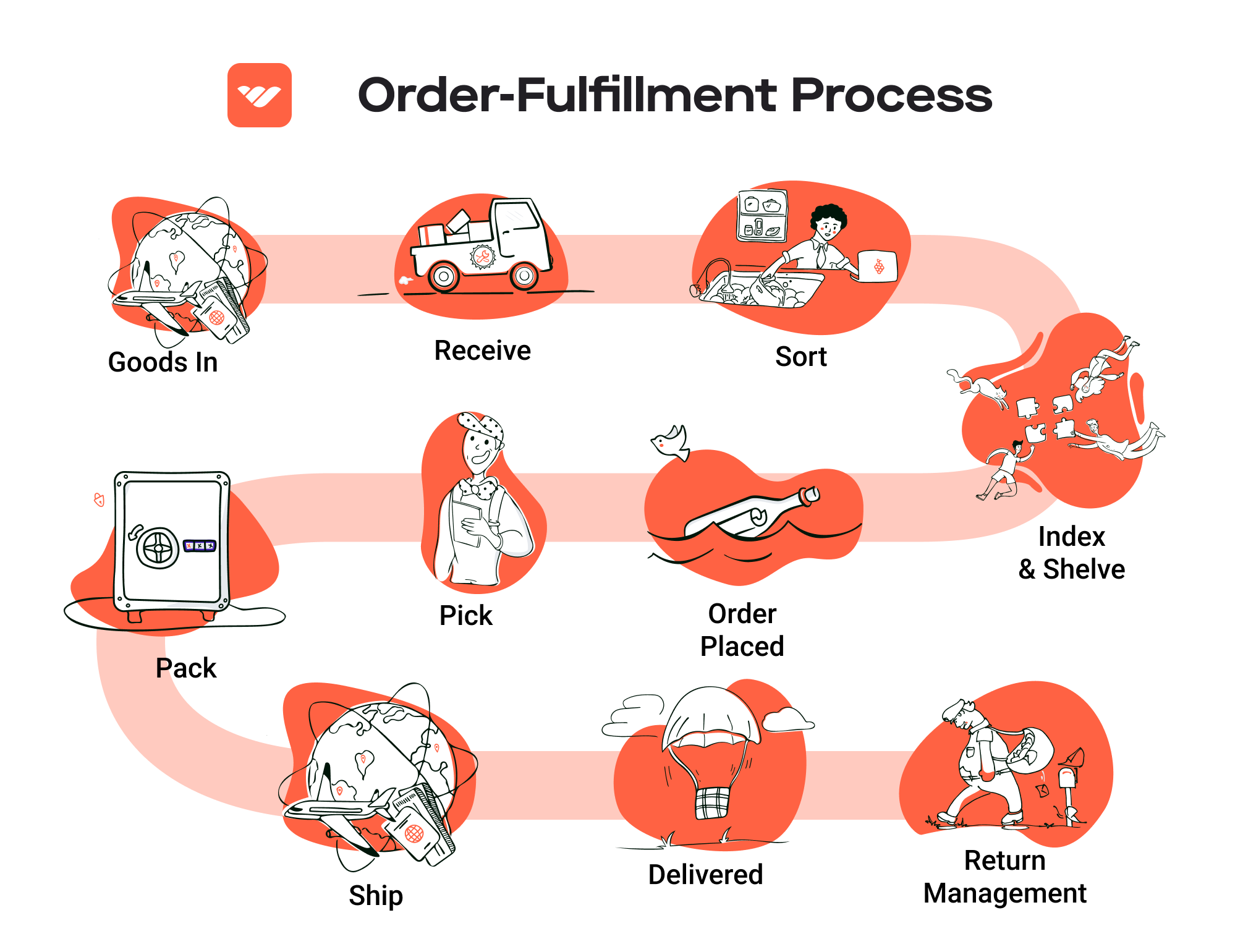
5. Shipping & Delivery
The final step in the order fulfillment process is shipping and delivery. Once orders are packed, they are labeled and dispatched to the shipping carrier for delivery to the customer. This stage involves selecting the best shipping options based on factors like speed, cost, and destination, and utilizing tracking systems to monitor the shipment’s progress.
Importance: Timely and reliable shipping is paramount for customer satisfaction and retention. Consumers expect fast delivery, and delays can lead to frustration and lost sales. Effective shipping strategies, such as utilizing nearshore fulfillment options, can drastically reduce transit times and costs, giving businesses a competitive edge.
Key Term: Last Mile Delivery – The final step of the delivery process where the package is transported from a distribution center to the end customer’s location, often considered the most critical part of the logistics chain.
By understanding and optimizing each step in the order fulfillment process, e-commerce businesses can enhance operational efficiency, reduce costs, and ultimately provide a superior customer experience. This structured approach is crucial for scaling operations and achieving long-term success in the competitive e-commerce landscape.
Comparing Fulfillment Models: In-House vs. 3PL vs. Dropshipping
Fulfillment Model Comparison Table
| Model | Who Handles Inventory | Best For (Business Stage) | Key Advantage | Key Disadvantage |
|---|---|---|---|---|
| In-House Fulfillment | Business (Own Staff) | Startups to Established Businesses | Complete control over inventory and processes | High overhead costs and resource allocation |
| Third-Party Logistics (3PL) | 3PL Provider | Growth Stage to Established Brands | Cost efficiencies and expertise in logistics | Less control over inventory and operations |
| Dropshipping | Supplier | Startups to Small Businesses | Low upfront investment and risk | Lower profit margins and reliance on suppliers |
In-House Fulfillment
In-house fulfillment refers to the process where a business manages its own warehousing, inventory, and shipping operations. This model is particularly suited for startups and established businesses that require complete control over their inventory and fulfillment processes. With in-house fulfillment, companies can customize their storage and shipping practices to align with their brand values, ensuring a consistent customer experience. The key advantage of this model lies in the ability to oversee every aspect of the supply chain, from receiving goods to packing and shipping orders. However, the disadvantages include high overhead costs, as businesses must invest in warehousing, staffing, and equipment. Additionally, as sales grow, scaling operations can become complex and resource-intensive, potentially leading to inefficiencies if not managed properly.
Third-Party Logistics (3PL)
Third-party logistics, or 3PL, involves outsourcing fulfillment operations to a specialized logistics provider. This model is ideal for businesses in the growth stage or those that have reached a level of maturity and need to optimize their logistics without investing heavily in infrastructure. 3PL providers, like Baja Fulfillment, offer a range of services, including warehousing, inventory management, and shipping, allowing businesses to focus on their core competencies such as marketing and product development. The key advantages of partnering with a 3PL include cost efficiencies, access to advanced logistics technology, and expertise in handling complex logistics operations. However, the trade-off is that businesses may have less control over their inventory and fulfillment processes, which can lead to potential discrepancies in order fulfillment and customer service.
Dropshipping
Dropshipping is a fulfillment model where the retailer does not hold inventory but instead transfers customer orders and shipment details directly to a supplier, who then ships the products directly to the customer. This model is particularly appealing for startups and small businesses looking to minimize risk and avoid upfront inventory costs. The primary advantage of dropshipping is that it requires very little initial investment, as businesses do not need to purchase stock upfront or manage a warehouse. However, dropshipping can lead to lower profit margins, as retailers often pay a premium for the convenience of not holding inventory. Additionally, reliance on suppliers for stock and shipping can result in delays, stockouts, and inconsistencies in product quality and customer service, which may ultimately impact brand reputation and customer satisfaction.
Conclusion
When deciding on a fulfillment model, e-commerce business owners must consider their current business stage, operational capabilities, and long-term goals. In-house fulfillment provides control but at a higher cost, while 3PL offers a balance of expertise and efficiency for scaling operations. Dropshipping, on the other hand, presents a low-risk entry point for new entrepreneurs but comes with challenges related to profit margins and supplier reliability. Each model has its unique advantages and disadvantages, and the best choice will depend on the specific needs and circumstances of the business.
A Deep Dive into Amazon FBA: Pros, Cons, and Who It’s For
Understanding Fulfillment by Amazon (FBA)
Fulfillment by Amazon (FBA) is a service provided by Amazon that allows e-commerce sellers to store their products in Amazon’s fulfillment centers. Amazon then takes care of storage, packaging, shipping, and customer service on behalf of the sellers. This allows sellers to leverage Amazon’s extensive logistics network and customer base, enabling them to focus on growing their businesses while ensuring a seamless shopping experience for customers.
When a customer places an order for a product that is fulfilled through FBA, Amazon picks, packs, and ships the product directly to the customer. The seller is notified of the sale, and once the product is shipped, Amazon handles all customer service inquiries, including returns and refunds.
How FBA Works
-
Set Up Your FBA Account: To get started with FBA, sellers must create an Amazon seller account and enroll in the FBA program.
-
Prepare Your Products: Sellers need to prepare their products according to Amazon’s guidelines, which include proper labeling and packaging.
-
Ship to Amazon: Once the products are prepared, sellers ship them to Amazon’s fulfillment centers. Amazon provides guidelines on how to send inventory and which fulfillment centers to use.
-
Storage and Fulfillment: Amazon stores the inventory in their warehouses. When a customer orders a product, Amazon picks it from the inventory, packs it, and ships it directly to the customer.
-
Customer Service and Returns: Amazon manages all customer service inquiries related to FBA orders, including handling returns and refunds, ensuring a hassle-free experience for sellers.
-
Payment and Reporting: After the sale, sellers receive payments through Amazon, minus FBA fees. Sellers can also access detailed reporting on sales, inventory, and performance metrics.
Pros of FBA
Prime Eligibility
One of the most significant advantages of FBA is that products become eligible for Amazon Prime. This membership program offers customers free two-day shipping on eligible items, making products more appealing to Prime members. Since Prime members tend to spend more, this can lead to increased sales for sellers.
Customer Trust
Using FBA enhances customer trust. Amazon is known for its reliable shipping and customer service. When customers see that a product is fulfilled by Amazon, they often feel more confident in their purchase, knowing that they can rely on Amazon’s return policies and customer support.
Multi-Channel Fulfillment
FBA allows sellers to sell products not only on Amazon but also on other platforms, such as their own websites or other marketplaces. This flexibility enables sellers to reach a broader audience while still benefiting from Amazon’s logistics and fulfillment expertise.
Scalability
FBA is designed to scale with your business. As sales increase, sellers can send more inventory to Amazon’s fulfillment centers without needing to invest in their own warehousing or logistics solutions. This scalability is particularly beneficial for businesses experiencing rapid growth.
Access to Advanced Analytics
Sellers using FBA have access to Amazon’s sophisticated analytics tools, which can provide insights into sales performance, inventory levels, and customer behavior. This data can help sellers make informed decisions about their product offerings and marketing strategies.
Cons of FBA
High Fees
While FBA provides numerous advantages, it also comes with high fees. Sellers are charged for storage space and fulfillment services, which can eat into profit margins. Additionally, fees can vary based on the size and weight of products, meaning sellers must carefully calculate their costs to maintain profitability.
Strict Inventory Rules
Amazon has strict rules regarding inventory management. Sellers must monitor their inventory levels closely, as running out of stock can lead to lost sales and potential penalties. Moreover, excess inventory incurs higher storage fees, forcing sellers to manage their inventory efficiently.
Commingling Risks
FBA products are often commingled, meaning that inventory from different sellers is mixed in Amazon’s warehouses. While this can lead to faster shipping times, it also poses risks. If a customer receives a damaged or counterfeit product from a commingled inventory, it can affect the seller’s reputation and lead to negative reviews, even if the issue was not their fault.
Limited Control Over Branding and Packaging
When using FBA, sellers have limited control over how their products are packaged and presented to customers. Amazon’s standard packaging may not align with a seller’s brand image, potentially impacting the customer experience and brand perception.
Dependency on Amazon
Relying on FBA can create a dependency on Amazon’s platform. Any changes to Amazon’s policies, fees, or algorithms can significantly impact a seller’s business. This reliance can make it challenging for sellers to diversify their sales channels and mitigate risks.
Who is FBA Best For?
FBA is particularly well-suited for:
- Small to Medium-Sized Businesses: Companies that lack the resources to manage their own logistics and fulfillment can benefit from FBA’s infrastructure.
- E-commerce Brands Seeking Growth: Businesses looking to scale quickly can leverage FBA’s capabilities to reach a wider audience without heavy investments in warehousing and logistics.
- Sellers with High Sales Volume: Those who anticipate consistent sales can benefit from FBA’s efficiencies, especially as storage and fulfillment costs can be offset by increased sales.
- Brands Prioritizing Customer Experience: Companies that want to enhance customer trust and satisfaction can take advantage of Amazon’s reputation and customer service capabilities.
In conclusion, while FBA offers numerous benefits that can help businesses scale and improve customer satisfaction, it is essential for sellers to carefully weigh the pros and cons. By understanding their specific needs and the implications of using FBA, businesses can make informed decisions that align with their growth strategies.
Core Services Offered by Fulfillment Centers
Inventory Management & Warehousing
Inventory management and warehousing are foundational services provided by fulfillment centers. This involves the systematic tracking of inventory levels, orders, sales, and deliveries, along with the physical storage of products in a dedicated facility. Fulfillment centers utilize advanced software systems to monitor inventory in real-time, ensuring that e-commerce businesses always have a clear understanding of stock levels.
Benefits:
1. Optimized Stock Levels: By maintaining accurate inventory records, e-commerce businesses can avoid overstocking or stockouts, both of which can negatively impact cash flow and customer satisfaction.
2. Space Efficiency: Fulfillment centers offer scalable storage solutions, allowing businesses to adjust their warehousing needs based on seasonal demand or sales fluctuations without the burden of managing their own warehouse space.
3. Cost Savings: By outsourcing warehousing, e-commerce businesses can reduce overhead costs associated with maintaining their own storage facilities, including rent, utilities, and labor.
Pick and Pack Services
Pick and pack services are critical to the fulfillment process, involving the selection (or “picking”) of products from the warehouse based on customer orders and their subsequent packaging (or “packing”) for shipment. This process is streamlined through organized storage systems and trained personnel, ensuring that orders are filled accurately and efficiently.
Benefits:
1. Speed and Accuracy: Fulfillment centers are designed to maximize efficiency, allowing for quick order processing and reducing the chances of errors that can occur in manual operations. This leads to improved customer satisfaction due to timely and accurate deliveries.
2. Scalability: As an e-commerce business grows, the volume of orders can fluctuate significantly. Fulfillment centers can easily scale their pick and pack operations to handle increased demand during peak seasons or promotional events without requiring significant investment in additional labor or infrastructure.
3. Quality Control: Many fulfillment centers implement quality checks during the picking and packing process, ensuring that the right products are shipped in good condition, which further enhances customer trust and reduces returns.
Kitting and Assembly
Kitting and assembly services involve bundling multiple products together into a single kit or preparing products for sale by assembling components. This service is particularly beneficial for businesses offering subscription boxes, promotional kits, or complex products that require assembly before shipping.
Benefits:
1. Enhanced Customer Experience: Offering customized kits or assembled products can provide a unique selling proposition, allowing businesses to differentiate themselves from competitors and enhance the overall customer experience.
2. Streamlined Operations: By outsourcing kitting and assembly, e-commerce businesses can focus on core operations such as marketing and product development while leaving the logistical complexities to experts.
3. Cost Efficiency: Fulfillment centers can often perform kitting and assembly at a lower cost due to their established processes and economies of scale, allowing businesses to save on labor costs and materials.
Returns Management (Reverse Logistics)
Returns management, often referred to as reverse logistics, is the process of handling returned products. This service is crucial for e-commerce businesses, where return rates can be significantly higher than in traditional retail. Fulfillment centers streamline this process by managing returns efficiently, from accepting returned goods to processing refunds or exchanges.
Benefits:
1. Customer Retention: An efficient returns management process can enhance customer loyalty. If customers know they can easily return products, they are more likely to make purchases, even if they are unsure about a product’s fit or quality.
2. Inventory Recovery: Fulfillment centers can quickly assess returned products and determine whether they can be restocked, refurbished, or need to be discarded. This helps businesses recover value from returned inventory and maintain accurate stock levels.
3. Data Insights: Handling returns provides valuable data on customer behavior and product performance. Fulfillment centers can analyze return trends, helping businesses identify issues with specific products and adjust their offerings accordingly.
In summary, the core services offered by fulfillment centers encompass a wide range of logistical solutions that are essential for e-commerce businesses looking to scale. By leveraging these services, companies can optimize their operations, enhance customer satisfaction, and ultimately drive growth in an increasingly competitive market.
How to Choose a Fulfillment Partner: A 6-Point Checklist
Location & Warehouse Network
The geographical placement of your fulfillment partner’s warehouses is crucial for minimizing shipping times and costs. A strategically located partner can help you reach your customers faster, which is essential for customer satisfaction and retention.
Questions to Ask:
– Where are your warehouses located, and how do they align with my target markets?
– Do you have multiple locations to facilitate quicker shipping options?
– How do you handle cross-border logistics, especially if I am shipping to the U.S. from Mexico or vice versa?
Technology & Integrations
In today’s e-commerce landscape, technology is a pivotal element in fulfillment. Your partner should offer robust software solutions that integrate seamlessly with your e-commerce platform, inventory management systems, and other tools.
Questions to Ask:
– What technology platform do you use for order management, and how does it integrate with popular e-commerce platforms like Shopify, Amazon, or WooCommerce?
– Can you provide real-time tracking for both inventory and shipments?
– How do you handle data security and compliance with regulations, particularly in cross-border transactions?
Specializations (e.g., Cold Storage, Oversized Items)
Not all fulfillment partners are equipped to handle specialized inventory types. If your products require specific handling (like cold storage for perishables or special packaging for oversized items), ensure your partner has the necessary capabilities.
Questions to Ask:
– What types of products do you specialize in fulfilling, and do you have the facilities to handle my specific needs?
– Can you accommodate special packaging requirements or product handling instructions?
– Do you have experience managing returns for specialized products?
Scalability & Capacity
As your business grows, your fulfillment needs will evolve. It’s essential to choose a partner who can scale operations alongside your business, whether you’re increasing order volumes or expanding into new markets.
Questions to Ask:
– What is your current capacity, and how quickly can you scale up to meet increased demand?
– How do you handle seasonal fluctuations in order volume?
– What infrastructure do you have in place to support rapid growth, and how quickly can you implement changes?
Pricing and Contracts
Understanding the pricing structure and contract terms is vital for maintaining healthy profit margins. Look for transparency in pricing and flexibility in contract terms to avoid being locked into unfavorable conditions.
Questions to Ask:
– Can you provide a detailed breakdown of your pricing model, including storage, shipping, and any additional fees?
– What are the contract terms, and is there flexibility for scaling or adjusting services?
– Are there penalties for early contract termination, and how do you handle pricing adjustments for unforeseen circumstances?
Customer Support & Reviews
Strong customer support is crucial for resolving issues quickly and efficiently. Additionally, researching reviews and testimonials can provide insights into the partner’s reliability and service quality.
Questions to Ask:
– What level of customer support do you offer, and how can I reach your team in case of issues?
– Can you provide references or case studies from businesses similar to mine?
– What is your average response time for customer inquiries, and how do you handle complaints or service disruptions?
Conclusion
Choosing the right fulfillment partner is a critical decision that can significantly impact your e-commerce operations. By carefully evaluating these six key areas, you can ensure that your selected partner aligns with your business goals and customer expectations. This thorough vetting process will not only save you time and money in the long run but also set your business up for scalable success in the competitive e-commerce landscape.
Understanding Fulfillment Pricing: A Breakdown of Common Fees
Initial Setup Fees
Initial setup fees are often the first costs you encounter when partnering with a fulfillment provider. These fees typically cover the onboarding process, which includes account creation, inventory integration, and system configurations necessary for smooth operations. The setup may also involve customizations to meet your specific business needs, such as branding requirements or unique inventory handling processes.
The calculation of initial setup fees can vary widely among fulfillment centers. Some providers charge a flat fee, while others may base their pricing on the complexity of your operations or the volume of inventory to be integrated. It’s essential to clarify what services are included in this fee and whether any additional costs may arise during the setup phase.
Receiving Fees
Receiving fees are charged when your inventory arrives at the fulfillment center. These fees cover the labor and resources required to unload, inspect, and store your products. The process typically involves checking the shipment against your purchase orders, verifying quantities, and ensuring that the products are in good condition.
Receiving fees are often calculated per pallet or per box, depending on how your inventory is packaged. For example, if you send a shipment of 10 pallets, you might incur a fee for each pallet received. Some fulfillment centers may also charge for additional services, such as quality checks or labeling during the receiving process. Understanding these fees upfront can help you budget more accurately.
Storage Fees (per pallet/bin)
Storage fees are incurred for keeping your inventory in the fulfillment center. These fees can be charged on a monthly basis and are typically calculated per pallet or bin. The cost may vary depending on the size and type of products you store, as well as the duration of storage.
For instance, if you have a high turnover of products, your storage fees may be lower than if you have items that sit in the warehouse for extended periods. It’s crucial to assess your inventory turnover rates and choose a fulfillment partner that offers competitive storage rates without compromising on service quality. Additionally, some providers may offer tiered pricing models based on the volume of stored inventory, which can lead to potential savings as your business scales.
Pick & Pack Fees (per item/order)
Pick and pack fees are charged for the labor involved in retrieving items from the warehouse and preparing them for shipment. This process includes picking the correct products, packing them securely, and labeling the packages for delivery. The fee can vary based on the complexity of the order, such as the number of items being picked or any special packaging requirements.
Typically, fulfillment centers charge on a per-item or per-order basis. For example, if your order consists of five different items, you may be charged a fee for each item picked and packed. Understanding how these fees are structured can help you optimize your order fulfillment process and potentially reduce costs by streamlining your inventory management.
Shipping Fees
Shipping fees are one of the most significant costs associated with fulfillment. These fees cover the transportation of your products from the fulfillment center to your customers. Shipping costs can vary based on several factors, including the shipping method (standard, expedited, etc.), the destination, package weight, and dimensions.
Most fulfillment providers negotiate shipping rates with carriers and may pass some of those savings onto you. It’s essential to understand how your chosen fulfillment partner calculates shipping fees and whether they offer options for discounted rates. Additionally, consider whether they provide tracking services and delivery guarantees, as these factors can significantly impact customer satisfaction.
Tips for Getting an Accurate Quote
-
Be Transparent: Provide detailed information about your inventory, including the types of products, average order volume, and any special handling requirements. The more information you share, the more accurate the quote will be.
-
Request a Breakdown: Ask for a detailed breakdown of all potential fees, including any variable costs that may arise based on your specific operations. This will help you avoid unexpected charges later.
-
Compare Providers: Don’t settle for the first quote you receive. Compare multiple fulfillment centers to understand the competitive landscape and identify the best value for your business.
-
Consider Scalability: Ensure that the fulfillment provider can accommodate your future growth. Ask about how fees may change as your order volume increases, and whether there are any discounts for higher volumes.
-
Negotiate Terms: Don’t hesitate to negotiate terms and fees. Many fulfillment providers are open to customizing their offerings to better fit your business needs.
By understanding these common fulfillment pricing models and following these tips, you can make informed decisions that support your e-commerce growth while managing costs effectively.
Frequently Asked Questions (FAQs) about Fulfillment
1. What is Baja Fulfillment?
Baja Fulfillment is a logistics and fulfillment service provider based in McAllen, Texas, specializing in helping e-commerce brands streamline their supply chain operations. By leveraging nearshore facilities in Mexico, they offer solutions like duty deferral, custom packaging, and fast cross-border shipping to enhance efficiency and reduce costs.
2. How does duty deferral work?
Duty deferral allows e-commerce brands to postpone or reduce import duties on shipments. Baja Fulfillment utilizes programs like IMMEX and bonded warehouses, enabling businesses to improve cash flow and lower landed costs, which helps protect profit margins while ensuring timely deliveries across the U.S.-Mexico border.
3. What services does Baja Fulfillment offer?
Baja Fulfillment provides a range of services beyond traditional warehousing, including:
– Kitting and assembly
– Custom packaging and labeling
– Returns management
– Quality control checks
– Fast shipping and logistics coordination
These value-added services help businesses enhance their customer experience and optimize operational efficiency.
4. What is the difference between a warehouse and a fulfillment center?
A warehouse primarily serves as a storage space for goods, focusing on inventory management. In contrast, a fulfillment center is designed to handle the entire order processing cycle, including picking, packing, shipping, and returns management. Fulfillment centers are equipped to handle the complexities of e-commerce logistics, ensuring timely delivery to customers.
5. What is a 3PL?
A Third-Party Logistics (3PL) provider offers outsourced logistics services to businesses. This includes services like warehousing, order fulfillment, transportation, and inventory management. By partnering with a 3PL like Baja Fulfillment, e-commerce businesses can scale their operations without the overhead of managing their own logistics infrastructure.
6. How much do fulfillment services cost?
The cost of fulfillment services can vary based on several factors, including order volume, storage needs, and additional services required. Generally, businesses can expect costs to include:
– Per-order fulfillment fees
– Storage fees based on inventory levels
– Shipping costs
To get a tailored quote, it’s best to contact Baja Fulfillment directly with your specific needs.
7. How does nearshoring benefit my e-commerce business?
Nearshoring with Baja Fulfillment allows businesses to reduce shipping times and costs by utilizing strategically located facilities in Mexico. This proximity to the U.S. market enables faster delivery, better inventory control, and enhanced flexibility in responding to customer demands.
8. Can Baja Fulfillment integrate with my e-commerce platform?
Yes, Baja Fulfillment offers integration with various e-commerce platforms, including Shopify, Magento, WooCommerce, and marketplaces like Amazon and eBay. This seamless integration allows for efficient order processing and real-time inventory management, enhancing your overall operational efficiency.
9. What types of businesses can benefit from Baja Fulfillment?
Baja Fulfillment primarily serves e-commerce businesses, ranging from startups to established brands with significant online sales. They cater to various industries, including electronics, apparel, and subscription services, making their solutions versatile for different business models.
10. How can I get started with Baja Fulfillment?
To get started, you can reach out to Baja Fulfillment through their website to request a quote or consultation. They will assess your business needs and provide tailored solutions that align with your operational goals, helping you scale your e-commerce logistics effectively.
Conclusion: Is Outsourcing Fulfillment the Right Move for Your Business?
Evaluating the Benefits of Outsourcing Fulfillment
Outsourcing your fulfillment operations can be a transformative decision for your e-commerce business. By leveraging a specialized fulfillment partner, you can unlock several key benefits that directly contribute to your growth strategy.
Time Savings: Managing logistics can be a time-consuming endeavor. By outsourcing fulfillment, you free up valuable resources that can be redirected toward core business activities, such as marketing, product development, and customer service. This shift allows you to focus on scaling your sales and enhancing customer experiences, which are crucial for long-term success.
Scalability: As your business grows, so do your fulfillment needs. An experienced fulfillment partner can easily adjust to fluctuations in order volume, whether during peak seasons or as your product lines expand. This scalability ensures you maintain efficient operations without the headaches of managing warehousing and staffing logistics in-house.
Expertise and Efficiency: A dedicated fulfillment service brings a wealth of expertise in logistics, inventory management, and compliance with regulations. This knowledge translates into improved operational efficiency, reduced shipping times, and ultimately a better customer experience. For instance, companies like Baja Fulfillment leverage nearshoring and duty deferral programs to optimize costs and enhance delivery speeds across the U.S.–Mexico border.
Choosing the right fulfillment partner is critical to your growth trajectory. A partner that aligns with your business goals can provide the necessary support to navigate complex logistics and scale effectively.
Take Action
Now is the time to assess your current shipping processes. Conduct a thorough audit of your logistics operations to identify inefficiencies or pain points. Consider whether a fulfillment partner could address these challenges and help you capitalize on growth opportunities. Take the first step toward optimizing your fulfillment strategy today—your future self will thank you.
Important Disclaimer
⚠️ Important Disclaimer
The information in this guide is for educational purposes. Fulfillment services, pricing, and platform features change frequently. Always conduct your own due diligence and consult with providers directly before making business decisions.
